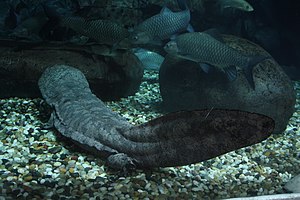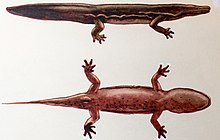Chinese giant salamander
| Chinese giant salamander | ||||||||||||
|---|---|---|---|---|---|---|---|---|---|---|---|---|

Chinese giant salamander in the aquarium in Shanghai |
||||||||||||
| Systematics | ||||||||||||
|
||||||||||||
| Scientific name | ||||||||||||
| Andrias davidianus | ||||||||||||
| Blanchard , 1871 |
The Chinese giant salamander ( Andrias davidianus ; Chinese 大鯢 / 大鲵 , Pinyin Dani - "Big Salamander" or 娃娃鱼 , wáwayú - "Baby Fish") is the largest extant amphibian in the world and also the largest occurring today salamander .
Occurrence
Andrias davidianus is widespread in China in cool to cold, very clean flowing waters in the catchment area of the Yangtze . During the day it hides under rocks, trees or underwashes.
features
Chinese giant salamanders are massive animals with a strongly flattened physique and a broad, laterally flattened tail. Adult specimens usually reach a total length of about one meter and a weight of over 10 kilograms, but there have been reports of individuals up to 180 centimeters long and weighing over 60 kg. On the dark brown to black or greenish basic color of the animals there are irregular spots, spots or marbling. The skin is rough with numerous pores, wrinkles and mostly small nodules in pairs.

The head is strongly flattened and broad with a wide mouth. The small round nostrils are close together and just above the upper lip at the corners of the blunt muzzle. The eyes are very small, lidless, and sit on the upper outer edges of the head. Behind them lies a rounded temple projection. The mouth has a thin fold of the lower lip that begins about halfway between the nostrils and the eyes and runs to the corners of the mouth. There is a large tongue in the mouth; Teeth sit in a large arch on the intermaxillary bone , upper jaw and in a parallel arch on the ploughshare between the choan openings . The trunk is a little less flattened than the head and has about 15 rib furrows and one furrow along the back. A pronounced fold of skin protruding to the side runs from head to tail. The legs are short and also flattened. The front legs have four toes, the hind legs five. The tail makes up about six tenths of the body length and is flattened on the sides with a circumferential fin edge that begins on the back on the trunk.
The Chinese species differs from the Japanese giant salamander ( Andrias japonicus ) in its darker color, a less rounded snout, a slightly longer tail and the arrangement of the skin nodules, which are smaller, less numerous and usually in pairs. On the throat of the Chinese giant salamander, there are very small nodules in rows that run parallel to the lower jaw, while the larger skin nodules of the Japanese type are individually and irregularly distributed.
Systematics
DNA comparisons of Chinese giant salamanders from different river systems show that the name Andrias davidianus conceals three, five and possibly eight different cryptic species . Since they do not go ashore, the different populations cannot reproduce with one another and are genetically isolated from one another. In a study published in September 2019, one of these species was identified as Megalobatrachus sligoi , which was described as early as 1924 by the British herpetologist Edward George Boulenger , but was later synonymous with Andrias davidianus . The species occurs in southern China in the catchment area of the Pearl River and now has the scientific name Andrias sligoi . Another safely identified as a separate species population comes in the waters of Huang Shan before -Gebirges and is still unwritten . The different species of the giant salamander occurring in China evolved from 3.1 to 2.4 million years ago when there was increased mountain formation in China .
Way of life
The Chinese giant salamander feeds on fish , other amphibians, crabs , shrimps and also on carrion . For reproduction , females deposit two strands of ice, each with around 500 eggs. The fertilization takes place externally. Only after two to two and a half months hatch from the eggs guarded by the males about three centimeters long larvae. The sexual maturity at the earliest in five. In zoological gardens, Chinese giant salamanders reach an age of over 60 years.
Giant salamander and human
The Chinese giant salamander and the Japanese giant salamander ( Andrias japonicus ) are the last recent species of this genus . Both are under the strictest international protection and may not be traded ( Washington Convention on the Protection of Species , Appendix I). In addition to the destruction of natural habitats, the greatest threat is human. Giant salamanders are considered a delicacy in China and their body parts play an important role in traditional Chinese medicine in the treatment of anemia . The species is officially protected in the People's Republic of China (in Zhangjiajie in the north of the province of Hunan a state nature reserve for the Chinese giant salamander has been established, in addition there are several others at other administrative levels). Today the Chinese giant salamander is in acute danger of extinction.
Individual evidence
- ↑ a b c Samuel T. Turvey, Melissa M. Marr, Ian Barnes, Selina Brace, Benjamin Tapley, Robert W. Murphy, Ermi Zhao and Andrew A. Cunningham. 2019. Historical Museum Collections Clarify the Evolutionary History of Cryptic Species Radiation in the World's Largest Amphibians. Ecology and Evolution. doi: 10.1002 / ece3.5257
- ↑ Cihai ("Sea of Words"), Shanghai cishu chubanshe, Shanghai 2002, ISBN 7-5326-0839-5 , p. 272.
- ↑ Dai Qiang, Wang Yuezhao, Liang Gang: Conservation Status of Chinese Giant Salamander (Andrias davidianus) . Ed .: Chinese Academy of Sciences. (English, full text at Critical Ecosystems Partnership Fund [PDF; 2.6 MB ]). Full text at Critical Ecosystems Partnership Fund ( Memento of the original from September 13, 2012 in the Internet Archive ) Info: The archive link was inserted automatically and has not yet been checked. Please check the original and archive link according to the instructions and then remove this notice.
- ↑ a b Description in Amphibiaweb
- ↑ Description at Edgeofexistence
- ↑ Fang Yan, Jingcai Lü, Baolin Zhang, Zhiyong Yuan, Haipeng Zhao, Song Huang, Gang Wei, Xue Mi, Dahu Zou, Wei Xu, Shu Chen, Jie Wang, Feng Xie, Minyao Wu, Hanbin Xiao, Zhiqiang Liang, Jieqiong Jin, Shifang Wu, CunShuan Xu, Benjamin Tapley, Samuel T. Turvey, Theodore J. Papenfuss, Andrew A. Cunningham, Robert W. Murphy, Yaping Zhang, Jing Che. The Chinese giant salamander exemplifies the hidden extinction of cryptic species. Current Biology, 2018; 28 (10): R590 doi: 10.1016 / j.cub.2018.04.004
- ^ Boulenger, EG (1924). On a new giant salamander, living in the Society's gardens. Proceedings of the Zoological Society of London, 1924, 173-174.
- ↑ Thorn, R. (1968). Les salamanders d'Europe, Asie et d'Afrique du Nord. Paris, France: Paul Lechevalier.
- ^ Andrias davidianus (Blanchard, 1871). In: Salamanders of China LifeDesk. Retrieved July 26, 2014 .
- ↑ Samuel T. Turvey, Shu Chen, Benjamin Tapley, Gang Wei, Feng Xie, Fang Yan, Jian Yang, Zhiqiang Liang, Haifeng Tian, Minyao Wu, Sumio Okada, Jie Wang, Jingcai Lü, Feng Zhou, Sarah K. Papworth, Jay Redbond, Thomas Brown, Jing Che, Andrew A. Cunningham. Imminent extinction in the wild of the world's largest amphibian. Current Biology, 2018; 28 (10): R592 doi: 10.1016 / j.cub.2018.04.005
Web links
- Report on Lan Hongming and its breeding in Yanxia, Guiding County, Guizhou Province - Chinese (with many photos)
- The Chinese giant salamander at edgeofexistence.org - English
- Entry of the Chinese giant salamander in the IUCN Red List of Threatened Species (English)
- Bea Riebesehl: New species is the largest salamander , Spektrum.de , September 17, 2019
